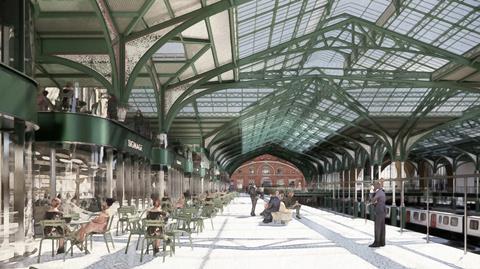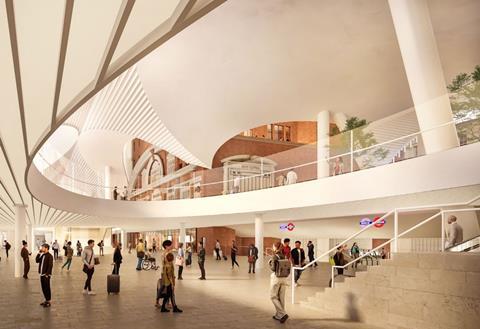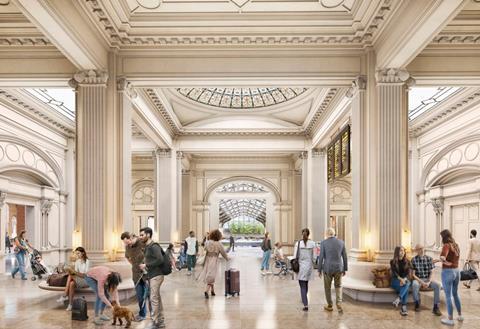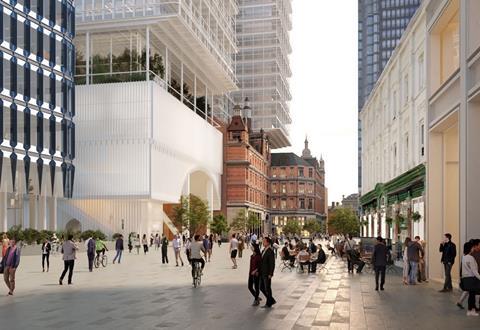A week after Herzog & de MeuronŌĆÖs divisive proposals were dropped, ║├╔½Ž╚╔·TV speaks to Network Rail and the schemeŌĆÖs new architect Acme about their ┬Ż1bn redesign of the listed stationŌĆÖs proposed overhaul, and what exactly has happened to development partner Sellar

It has been one of the most talked about projects in London since the pandemic. The redevelopment of Liverpool Street station, first revealed by ║├╔½Ž╚╔·TV in March 2022, has been a regular presence in local, trade and national press for more than two years. Controversial from the beginning, its radical proposal to transform the Victorian station has provoked the ire of heritage bodies, campaign groups, neighbouring councils and, worst of all, celebrities. And with a development value of around ┬Ż1.5bn, it is also one of the biggest jobs in the capital.
Last week the long-running saga took another twist, with the schemeŌĆÖs client, Network Rail, scrapping its original plans and unveiling an entirely new proposal designed by a different architect. London-based Acme has taken over from former lead architect, the celebrated Swiss practice Herzog & de Meuron, while Network RailŌĆÖs development partner Sellar, the developer of the Shard, has effectively been dropped.
The result is a dramatically scaled back scheme which Network Rail believes will cost around a third less to build, coming in at a cost of around ┬Ż1bn, and with a design which aims to be much more sympathetic to the grade II-listed station and its grade II*-listed neighbour, the former Great Eastern Hotel.
While Herzog & de Meuron had envisaged a series of futuristic white-coloured arches flowing through the station concourse, AcmeŌĆÖs plans are so Victorian in style that the published visuals of the designs may as well have included men wearing frock coats and top hats. And the schemeŌĆÖs most controversial component, a 20-storey office tower cantilevered above the listed hotel, has been reduced by three storeys, covered in campaigner-placating greenery and shifted over the train shed roof.

Network RailŌĆÖs volte face has been a big topic of conversation in the industry. What many want to know is what exactly had happened to Sellar, which had until then been effectively leading the project with its consultant team.
Since the beginning of the year, the developer and Herzog & de Meuron had also been overhauling their proposals, which had amassed no less than 2,200 objections from members of the public since being submitted in 2023, and were preparing to submit a revised application in the spring. Now those plans appear to be dead in the water, although, curiously, the application is yet to be withdrawn.
Trouble appears to have been brewing since at least the middle of last year, when Network Rail brought in Acme to provide a peer review of the scheme. At the time, the City of London was engaged in a protracted process of validating SellarŌĆÖs application. Although it had been submitted in May, it was not made public on the CityŌĆÖs planning portal until October.
By the end of that year, with criticism of the revealed plans mounting, Sellar was already redesigning the scheme and holding pre-application meetings with City planning officers ahead of the submission of a fresh application. This culminated in a new, more heritage-sensitive design shown to Network Rail executives in July. They appear not to have been convinced, responding by officially appointing Acme as lead architect to take forward its alternative design and abandoning SellarŌĆÖs rethink, which the developer had funded itself.

Robin Dobson, group property director at Network Rail Property and the man effectively in charge of the scheme, describes the move as a ŌĆ£bold decision and the right decisionŌĆØ, coming after the transport operator had ŌĆ£taken stock over many months to work out how we best move forward with the projectŌĆØ.
This has meant the appointment of an entirely new consultant team, with Acme replacing both Herzog & de Meuron and transport architect Scott Brownrigg, Gleeds replacing Gardiner & Theobald on costs, Aecom replacing WSP as engineer, SLA replacing Townshend as landscape architect, Gerald Eve replacing DP9 as planning consultant and Donald Insall Associates replacing Bridges Associates on heritage.

It also involves, according to Dobson, ŌĆ£fresh thinkingŌĆØ on how to work with heritage groups and aims to learn from the backlash that greeted the initial proposals.
Historic England, the all-important statutory consultee that savaged the original scheme in an official objection calling for the application to be refused, was the first group shown AcmeŌĆÖs new plans. The new team has already held meetings with more than 30 different stakeholders, including the Victorian Society, which became the standard bearer for the campaign to bring down the Sellar scheme. ŌĆ£I think it is really important to make people part of the journey and part of the consultation process,ŌĆØ says Dobson. ŌĆ£And that wasnŌĆÖt done effectively in the previous application.ŌĆØ
Previous Liverpool Street Station coverage
>> SellarŌĆÖs ┬Ż1.5bn Liverpool Street station plans hit by more than 2,000 objections
>> Sellar unveils new visuals of ┬Ż1.5bn Liverpool Street plans as application is finally made public
Dobson is speaking to ║├╔½Ž╚╔·TV in the station itself, three days after AcmeŌĆÖs plans were unveiled. Ironically, he has just come from a meeting with Sellar, which is still holding regular meetings with Network Rail on a potential future role on the scheme. But Dobson says he will now not appoint a development partner until after the new proposals receive planning permission, and is in the meantime speaking to ŌĆ£all development partners that are in and around the private sector marketŌĆØ. Another source involved in these talks has said there is still ŌĆ£potentially a roleŌĆØ for Sellar, especially in developing the schemeŌĆÖs overstation office building, although they admitted it was ŌĆ£clear the contours had shiftedŌĆØ. What is not in doubt is that Network Rail is now in the driving seat.
Standing next to Dobson in the station is Friedrich Ludewig, the founder of Acme. He describes his firmŌĆÖs approach to the project as ŌĆ£fundamentally differentŌĆØ to what had been drawn up by Herzog & de Meuron. The key design change, targeted directly at the heritage groups, is the decision not to touch the former Great Eastern Hotel.
Under SellarŌĆÖs original plans, parts of the grand 19th century buildingŌĆÖs ground floor would have become an extension of the station concourse, with one opulently decorated room even featuring a train timetable hung from the ceiling. The hotel would also have been flanked on one side by a dramatic new entrance designed in a strikingly different architectural style, and, most controversially, oversailed by an 800,000 sq ft office block built directly over its roof. Above ground floor, the hotel would be converted to office use.

Historic England said in its objection that the scheme would have procured commercial space ŌĆ£at the expense of extraordinary harm to the capitalŌĆÖs historic environmentŌĆØ, describing the proposals as ŌĆ£fundamentally misconceivedŌĆØ. The hotelŌĆÖs historic and architectural significance would be undermined by the ŌĆ£highly overbearing upward extensionŌĆØ which would ŌĆ£go to the heartŌĆØ of its significance, the group said.
Last October, when the original project team released images of its plans to transform the Great Eastern Hotel, it said the scheme would involve removing modernised elements that have altered the original character of the building, in order to ŌĆ£bring out its unique character and historical featuresŌĆØ.
We have worked hard to do something respectful to the hotel
Friedrich Ludewig, the founder of Acme
Changing the hotelŌĆÖs use into office space would have been a ŌĆ£really invasive thing to do,ŌĆØ Ludewig says. After the debacle of the last application, the new team is in no mood to take risks on heritage. ŌĆ£We hope to be a good neighbour,ŌĆØ he says, adding that the team had worked hard to ŌĆ£do something which is respectful to the hotelŌĆØ.
AcmeŌĆÖs plans steer well clear of all parts of the station that are listed, focusing entirely on the 1980s and 1990s extension which constitutes around a third of the train shed. This serves another purpose, of simplifying the construction programme and allowing the scheme to be built out quicker, which Dobson says is a significant factor in shaving ┬Ż500m off the construction cost of the scheme compared with the former plans.
Still, a significant portion of this roof directly above the concourse will be removed and replaced with a new structure, albeit in a similar colour scheme to the shedŌĆÖs Victorian arches, in order to provide support for the office building above. The latter, although reduced in size to 650,000 sq ft, is still needed to ensure the schemeŌĆÖs viability and has already attracted interest from potential occupiers.

Another factor influencing the design is the need to increase capacity at the station, which has seen passenger numbers soar beyond pre-pandemic levels since the opening of its Elizabeth Line which calls at Liverpool Street. It has now overtaken Waterloo as the countryŌĆÖs busiest station, with 100 million passengers a year and projected to see 140 million pass through its doors by 2050.
Regular visitors to the station will be familiar with the chaotic scene at rush hour with commuters queuing for an insufficient number of escalators, and swarming through the narrow concourse area. But these numbers also mean that it has some of the most valuable retail space in London. The Greggs and Boots, located on the concourse level, are the respective brandsŌĆÖ best performing stores in the country. It is this potential which is motivating Network Rail to transform the station into a ŌĆ£destination in its own rightŌĆØ, according to Dobson.
It will be one of the fastest planning applications of a project of this scale and this complexity in the City of London
Robin Dobson, Network Rail Property group property director
LudewigŌĆÖs plans would see the concourse opened up, with the large flight of steps which partially blocks the main entrance to the stationŌĆÖs underground lines removed to improve wayfinding. A new set of escalators would lead up to an expanded mezzanine level which would become a public route leading directly from the stationŌĆÖs main entrance on Liverpool Street to Exchange Square. This 230m long walkway would flank the entire length of the stationŌĆÖs western wall, providing new views of the buildingŌĆÖs cavernous train shed and bringing additional footfall to the underused square.
Another walkway along the eastern wall would contain retail space, relocating the current row of shops running above the stationŌĆÖs ticket gates which currently blocks views of the train shed. This space would be replaced by an unobstructed walkway with a glass wall, allowing visitors entering through the stationŌĆÖs main entrance to see all the way through the building to Exchange Square.

This would be a marked change from the existing station arrangement, which obscures views of the buildingŌĆÖs true scale to visitors unless they are standing on the National Rail platforms, excluding the tens of millions who only use the station to access its underground lines. Dobson says the team has been striving to create a ŌĆ£sense of theatre, a sense of entrance wow factorŌĆØ. It is being done in a way that Ludewig says is ŌĆ£inspired by the Victorians without copying the VictoriansŌĆØ, aiming to create a ŌĆ£cathedral-likeŌĆØ concourse space which exists in harmony with the listed buildings.
After a delay of at least a year caused by opposition to the previous proposals, the new team is in a hurry to get the scheme moving. ŌĆ£ItŌĆÖs unprecedented in terms of the speed at which we are working,ŌĆØ Dobson says.
Planning is expected to go in as soon as January, just over six months after the appointment of Acme. This amounts to less than half the time it took Sellar and Herzog & de Meuron to submit its planning application, although the time needed for the original plans is not unusual for a development of this size and complexity being worked up from scratch. Nevertheless, Dobson claims ŌĆ£it will be one of the fastest planning applications of a project of this scale and this complexity in the City of LondonŌĆØ. How have they managed it? ŌĆ£Because weŌĆÖre all quite good.ŌĆØ
So is the Sellar scheme truly dead? Heritage campaigners will be relieved to hear that it almost certainly is, although Sellar may have not quite thrown in the towel. The developer is still in regular dialogue with Network Rail and the planning application is still conspicuously active on the CityŌĆÖs planning portal. One project insider claims there are no plans to withdraw it and Herzog & de MeuronŌĆÖs revisions could ŌĆ£feed intoŌĆØ the final design. This version of the project was still in development only a month ago, according to another project source, even as Network Rail was preparing to go public with its alternative plans.
But Network RailŌĆÖs refusal to comment on SellarŌĆÖs proposed redesign speaks volumes. Dobson says its silence was ŌĆ£for a good reason. Because our focus is not the existing application. Our focus is the new application.
ŌĆ£And itŌĆÖs a very different approach and a very different scheme.ŌĆØ


























No comments yet